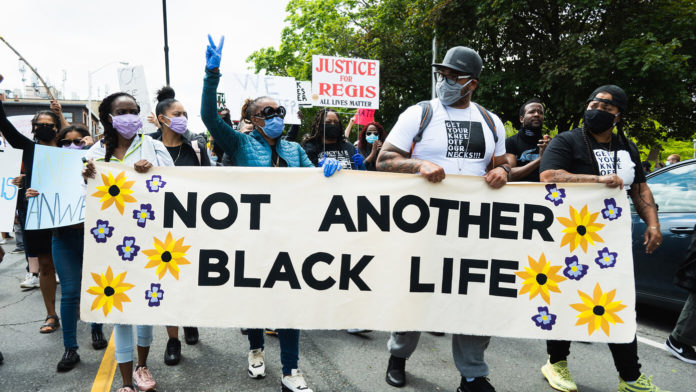For many Canadians, the thought of completely defunding the police may seem like a radical idea. What would happen without a police force to prevent or punish crime? And what would the alternative look like?
Amidst unrest in Canada and the United States over recent deaths of Black people involving the police, dismantling the police is an idea that is starting to gain attention. Thousands of Torontonians marched in support of justice for 29-year-old Regis Korchinski-Paquet, a young woman of Black and Indigenous heritage who fell from her balcony to her death with only the police with her in her apartment. Her family was just outside in the hall.
Korchinski-Paquet was in a mental health crisis. Multiple calls were made to the police to report an assault involving a knife, but her family insists that there was no knife at the time the police arrived. Instead of de-escalating the situation, protocols still dictated sending in armed officers to handle the situation.
It raises serious questions about whether this was the best way to handle the call for help and the role that race plays in interactions with police. A mother called the police for help and her daughter died. The officers weren’t equipped to help.
From 2000-2017, a CBC investigation found 461 fatal police encounters in Canada. Seventy percent of victims suffered from mental health and substance abuse problems. Black and Indigenous people are also strikingly overrepresented in these cases. Despite making up only 8.3 percent of the population of Toronto, Black people represented 37 percent of the city’s fatalities. In Winnipeg, Indigenous people make up 10.6 percent of the population, but make up almost two thirds of victims.
It would be naive to say that systemic racism doesn’t exist in Canada the way it does in the United States. We are home to thousands of cases of missing and murdered Indigenous women. It fits the legal definition of genocide. Suicide rates are at crisis levels. The last federally operated residential school was still in operation until 1996. There is deep, recent, and intergenerational trauma in these communities.
Black and Indigenous neighbourhoods happen to be the same communities that are disproportionately targeted by the police. Increased police presence, where officers have lawful authorization to kill, doesn’t make these communities feel safer against crime. We can’t deny their lived experience because not everyone has had the same negative interactions with police.
The RCMP was an institution created to control Indigenous people and their (stolen) land, says Jocelyn Thorpe, professor of history and women and gender studies at the University of Manitoba. It’s hard to see how reform could reverse an entrenched racial bias.
“The police will continue to remain a threat to the lives of Black and Indigenous communities unless we acknowledge the larger narrative of a colonial paradigm,” said Alicia Boatswain-Kyte, assistant professor of social work at McGill University in a press release.
“Whiteness throughout history and still today, has provided the lens through which all institutional structures were built. Law enforcement in a society where Black people’s existence cannot be separated from the role of ‘other’, is a contemporary manifestation of how governments have used violence to subjugate Black and Indigenous communities for centuries.”
The Canadian police are also increasingly militarized. Having these types of weapons means that they will sometimes use them. We need to ask important questions about whether this keeps Canadians safe, or puts them at heightened risk.
“Deployments of SWAT teams — special weapons and tactics units — have risen in major Canadian cities and are higher in some cases than those by U.S. public police,” write Kevin Walby, associate professor of criminal justice at the University of Winnipeg and Brendan Roziere, law student at the University of Manitoba in The Conversation.
“Based on our research, we can see that militarization has been normalized within Canada’s largest police services. SWAT teams, once considered a last-resort option for police forces, are now being used in routine areas of policing.”
The COVID-19 pandemic has only exacerbated problems by giving unprecedented police access to personal health information and more resources to surveil marginalized communities. Ethnicity and socio-economic status are factoring into the breakdown of who is more likely to become ill.
Race is a factor in whether a Canadian is likely to have an essential job, many at minimum wage, forcing them to continue to work through the pandemic. It should come as no surprise that the virus is disproportionately affecting low-income, racialized, and immigrant communities.
Dismantling the police force would leave a vacuum for other services to fill. There would still be a need for trained personnel to defuse ongoing violent crimes. But what is known to actually prevent crimes are well-funded social services.
Canada’s operating expenditures for policing totaled $15.1 billion in 2017/2018. Divesting in policing could open up funding for social workers, mental health crisis and addiction experts, low-income housing and shelters, and community and job programs.
The status quo isn’t meeting the needs of our communities equally or equitably, and we have a lot of work to do within our own borders. This is a much-needed national discussion that is long overdue, and outside-the-box thinking is exactly what is needed for change.








































